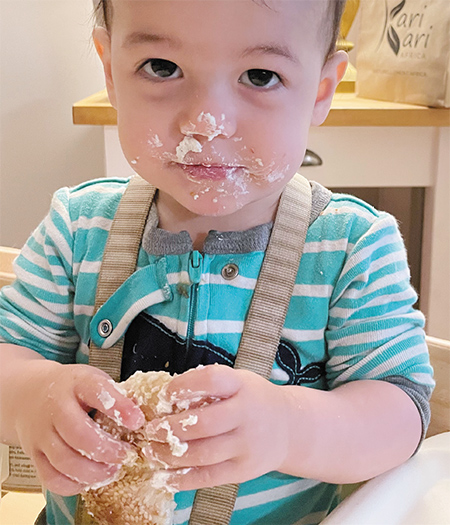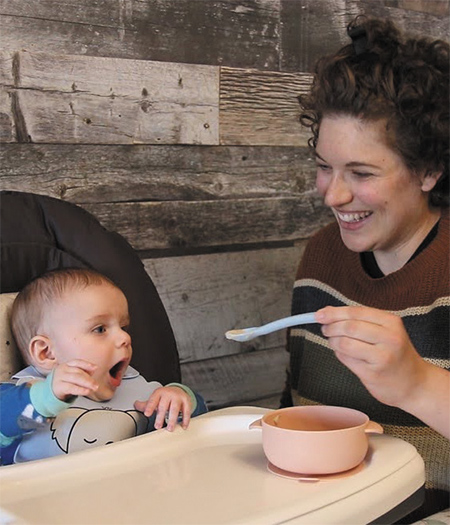How should I introduce foods?
Parents choose different ways to introduce solid food depending on their preferences, their family circumstances, and their baby’s characteristics.
Most parents introduce solids in the form of purée, which they give to their baby with a spoon. Over time they gradually introduce food with other textures.
Other parents prefer to start with food in pieces, letting the baby feed himself. This method is known as baby-led weaning (or BLW).
For more information on these two methods, see Baby food basics and Baby-led weaning (BLW).
Some advice applies to all babies, regardless of how solid food is introduced. See, for example, the information below and on pages Choking risk: Be extra careful until age 4 and Honey—never for babies under age 1.
Order of introduction
![]() The important thing is to start with iron-rich foods, then continue with a nutritious variety of foods.
The important thing is to start with iron-rich foods, then continue with a nutritious variety of foods.
The order in which foods are introduced varies from country to country, depending on customs and culture.
However, it is recommended to start with iron-rich foods, then to continue with nutritious and varied foods (see Start with iron-rich foods).
Good to know...
Cow’s milk should not be introduced before 9 to 12 months.
New foods
You can add new foods to your baby’s diet on a daily basis for several days in a row. There’s no need to wait a few days between two new foods.
When introducing new foods, continue to give your baby the foods she already knows on a regular basis.
Don’t insist if your baby refuses a new food for a few days. Try introducing it again later. You may have to present a food a number of times (up to 10 and sometimes even more) before your baby accepts it. This is how she learns to like new flavours.
A word about food allergies
The foods most likely to cause allergies are eggs (see Eggs), peanuts and other nuts (see Peanut and nut butters), fish and seafood (see Fish) and foods that contain cow’s milk protein (see Milk and dairy products).
In the past, it was recommended that parents wait until their babies had reached a certain age before introducing foods more likely to cause allergies. We now know that it’s best to introduce these types of foods at the same time as other solids.
When your baby tries a new food that could cause an allergy, watch her. To learn about the signs of an allergic reaction and what to do, see Food allergies. If she tolerates the new food, continue to offer it several times a week, in normal quantities for her age.
To find out if your baby has a higher risk of developing a food allergy or to learn more about food allergies, see Food allergies.
Food quality
Over time, solids will become more and more important in meeting your baby’s nutritional needs. That’s why the food you offer should be nutritious and varied.
The foods you add to your baby’s diet can often be the same as what the rest of the family eats. For ideas on nutritious foods to offer your baby, see 6 to 12 months—Your baby’s first foods.
However, it’s best not to give foods containing added salt or sugar to your baby until she’s at least one year old.
Quantity and frequency
Your baby has a small stomach, so he needs to eat small portions several times a day. At first, your baby will probably eat the equivalent of a few small spoonfuls once or more during the day.
Little by little, the amount of food and the number of meals and snacks will increase. Let yourself be guided by his appetite, which will vary depending on how much milk he drinks and his growth rate.
![]() Your baby’s appetite is your best guide to knowing how much food he needs. The quantity will depend on how much milk he drinks and will vary depending on his rate of growth.
Your baby’s appetite is your best guide to knowing how much food he needs. The quantity will depend on how much milk he drinks and will vary depending on his rate of growth.
You could, for example, start by giving him two or three meals a day. Then depending on how much he eats, you could add snacks in between meals.
By around 1 year of age, your child will be able to adopt a more regular schedule for meals (breakfast, lunch, supper) and snacks (between meals and at night, as needed).
Good to know...
When your baby starts eating foods, the number of breast or bottle feedings will generally stay the same. The amount of milk he drinks will not decrease by much. At around 8 or 9 months, he will gradually start drinking less.
Your baby can have his milk before or after foods, or you can give him some before and some after.
Appetite
![]() It’s possible that your child will eat less when she starts eating independently. Don’t insist: she is learning about foods and getting to know her own appetite. This will allow her to develop a healthy relationship with food. Trust your baby: she knows when she’s hungry and when she’s full.
It’s possible that your child will eat less when she starts eating independently. Don’t insist: she is learning about foods and getting to know her own appetite. This will allow her to develop a healthy relationship with food. Trust your baby: she knows when she’s hungry and when she’s full.
A baby’s appetite is like an adult’s: it can vary from one day to the next. It’s normal for babies to sometimes eat less, and it’s possible that they may not like certain foods or textures.
By watching your baby for specific signals, you’ll learn to know her appetite. If your baby shows interest in the food you give, it’s because she is still hungry, and you can continue feeding without hesitation. However, if she closes her mouth, refuses to eat, pushes her spoon away, turns her head, cries, or plays with her food, she is signalling that she has had enough to eat.
Independence
![]() Even if she eats on her own, your baby should be supervised at all times during meals.
Even if she eats on her own, your baby should be supervised at all times during meals.
Babies love bringing food and objects to their mouths. Let your child start eating with her fingers as soon as possible. It’s messier and often takes more time, but it’s a lot more fun!
Eating with her fingers also helps develop her motor skills (see Fine motor skills). Encourage her, because that’s how she learns to eat by herself—it’s an important step to becoming more independent!
First meals

![]() By around 1 year of age, your child should be able to eat foods in a variety of textures.
By around 1 year of age, your child should be able to eat foods in a variety of textures.
While some babies have no trouble adapting to meals, others find it difficult. To make things easier, choose a time when your baby is in a good mood.
The movements involved in eating are very different from those your baby uses for nursing. It takes time to learn. Your baby will need several weeks of practice to develop his abilities.
My baby refuses to eat

![]() Your baby needs time to develop her sense of taste and adapt to change.
Your baby needs time to develop her sense of taste and adapt to change.
If your baby refuses to eat, she may not be ready. If you’re not sure, see How do I know my baby is ready?
If you think your baby is ready, but she still refuses to eat, try again at the next meal and keep trying for one or two more days. You can also offer her a different food: maybe she didn’t like what you served.
If your baby is over 6 months and still refuses to eat after repeated attempts, consult a health professional.
Gagging
When your baby starts eating, small amounts of food may lodge in his throat without being swallowed. This can cause your baby to gag, as if he were about to vomit.
Your baby will cough and spit up the food he was given. Don’t worry, this is a normal reaction (gag reflex) that protects against choking.
However, if this happens at every meal for several days in a row, see a doctor.


